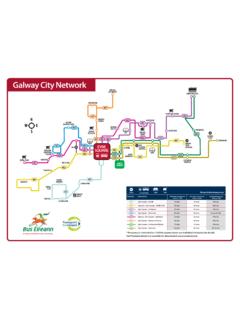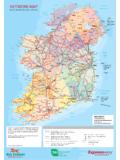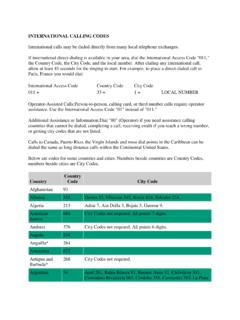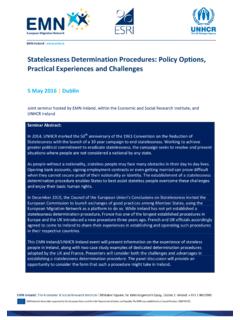Transcription of National Oversight and Audit Commission
1 National Oversight and Audit Commission Performance Indicators in Local Authorities 2015. NOAC Report No. 11 November 2016. NOAC (the National Oversight and Audit Commission ) was established in July 2014 under the 2014. Local Government Reform Act to provide independent Oversight of the local government sector. The statutory functions assigned to NOAC include the scrutiny of the performance of local government bodies against relevant indicators (including indicators relating to customer service). that the Commission considers it appropriate to refer to. This report is based on data provided to the Local Government Management Agency by the 31 local authorities in response to a reporting guidelines document issued by NOAC in March 2016.
2 TABLE OF CONTENTS. INTRODUCTION 1. FOLLOW-UP TO RECOMMENDATIONS IN THE 2014 PERFORMANCE INDICATORS. REPORT .. 2. COLLECTING THE 2015 PERFORMANCE INDICATOR DATA .. 3. QUALITY ASSURANCE REVIEW OF THE DATA . 4. PERFORMANCE INDICATOR DATA KEY MESSAGES 10. PERFORMANCE INDICATORS REPORT 2015 CONCLUSIONS .. 21. TABLES. SECTION 1: HOUSING 23. SECTION 2: ROADS .. 31. SECTION 3: WATER .. 44. SECTION 4: WASTE/ENVIROMENT .. 46. SECTION 5: PLANNING . 51. SECTION 6: FIRE SERVICE 54. SECTION 7: LIBRARY/RECREATION . 58. SECTION 8: YOUTH/COMMUNITY 60. SECTION 9: CORPORATE . 62. SECTION 10: FINANCE .. 66.
3 SECTION 11: ECONOMIC DEVELOPMENT .. 74. LGMA COMMENTARY . 76. Introduction 77. Housing .. 81. Roads 83. Water & Environment .. 86. Planning . 87. Fire Service .. 89. Library Service .. 92. Youth & Community . 94. Corporate . 95. Finance .. 96. Economic Development . 97. Introduction This report scrutinising local authority performance in 2015 against indicators selected by NOAC is the second Performance Indicator report published by NOAC in replacement of the service indicator reports previously published by the Local Government Management Agency (LGMA) in respect of activity from 2004 to 2013.
4 Following on from the experience of compiling the 2014 report NOAC made a number of changes to the set of indicators that local authorities were asked to report on in respect of 2015 activity. This report contains data in respect of 31 indicators in the areas of Housing (6), Roads (3), Water (1), Waste/Environment (3), Planning (4), Fire Service (3), Library/Recreation (2), Youth/Community (2), Corporate (4), Finance (2) and Economic Development (1). Amendments were made to the data captured in the case of 8 of these indicators. The data was collected by the LGMA and the detailed results for each indicator are provided in Tables 1 to 28 on pages 23 to 75 of this report.
5 The LGMA's associated commentary on the information provided by the indicators is at pages 76 to 97. A summary of the information provided by authorities in the follow-up to the 2014 report is on page 2. The report of NOAC's quality assurance review of six of the 2015 indicators and of its assessment visits to six of the 31 local authorities is at pages 4 to 9. Key messages from the indicator data and comparison, where possible, with 2014 performance by local authorities in delivering services to their local communities are highlighted on pages 10 to 20. Finally, NOAC's Conclusions arising from the experience of the data compilation and analysis are at pages 21and 22.
6 As applied in the case of the 2014 report, there is a small amount of overlap between NOAC's analysis of local authority performance as indicated by the data and the LGMA's commentary on the data outcomes. NOAC appreciates the efforts involved within the local government sector in ensuring that a robust system is in place to compile the indicators, to assist NOAC in its verification and validation process and to review the published indicators annually to inform efforts to improve performance. NOAC. wishes to convey its thanks to all involved in the process of compiling this report at local authority level, in the LGMA, staff of the Departments of Housing, Planning, Community and Local Government, Tourism, Transport and Sport and Jobs, Enterprise and Innovation and, in particular, the NOAC secretariat.
7 1. Follow-up to Recommendations in the 2014 Performance Indicators Report Following the publication of the Report on Local Authority Performance Indicators 2014, NOAC. wrote to Chief Executives in an effort to establish progress in relation to the implementation of the NOAC recommendations in the Report and also to seek any learning in relation to the contributory factors that led to performance which varied significantly from the median in a number of cases. The report recommended that local authorities implement the following: Establish targets related to the indicators to assist in assessment of outturns Present the targets and indicator outcomes to their management teams, elected members and Audit Committees Review annually (by their management teams, elected members and Audit Committees).
8 Year-on-year indicator performance by reference to comparable authorities and against targets Analyse the cost indicators to identify the factors underlying significant variations in performance by comparable authorities to ensure that value for money is being achieved and to facilitate the sharing of approaches to efficiency measures While there was some ambiguity/gaps in a small number of the responses received, the vast majority indicated that they had either implemented, agreed to implement or work was on-going regarding the various recommendations. Further to a data analysis exercise conducted on the 2014 data, 10 Chief Executives received a more detailed follow up letter with specific queries on a selection of 3-5 of their outlying indicators.
9 The aim of this exercise was to encourage Councils to review the relevant indicators to see what the underlying contributory factors to the variance in performance might be and to increase NOAC's understanding of the data. The responses contained a variety of explanations and clarifications. NOAC intends to engage in a similar exercise following the publication of this report on 2015 activity. 2. Collecting the 2015 Performance Indicator Data As flagged in the 2014 report, NOAC, in conjunction with the LGMA, reviewed the 2014 indicators and the associated guidelines to local authorities in relation to the provision of the data.
10 Arising from this, changes were made to the roads, water, pollution, library visits, Comhairle na n g, Public Participation Network, website and revenue account balance indicators. The indicators relating to waste complaints and facility permits, unaccounted for water, Gateway participants and Goal 3. employment supports were dropped. The guidelines were expanded to provide more detail as to what should be included or excluded, particularly in relation to the housing indicators. In the 2014 Performance Indicator report, NOAC referred to its disappointment at the delay in finalising the 2014 data, which resulted in publication of the report as late as 16 December 2015.






